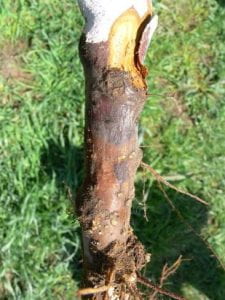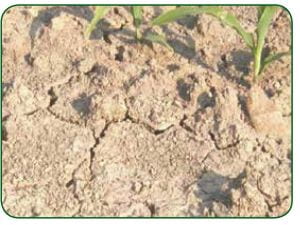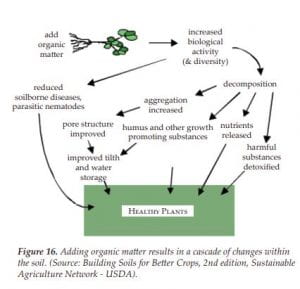Mike Basedow, CCE-ENYCHP
As a follow up to our soil health session at the 2022 Cornell Tree Fruit Conference, I thought I would briefly discuss what I consider to be some of the key characteristics of a high-quality orchard soil. I think a good way to think about this is by thinking through what some of the key functions of an orchard soil are.
A high-quality soil should be relatively free of organisms that cause soil borne diseases.
There are numerous soil organisms that can be detrimental to orchard longevity. Several species of Phytopthora cause root and crown rots. Phytophthora rots can girdle the scion (collar rot), damage the rootstock just below the soil surface (crown rot), and cause necrosis and death of fine roots (root rot). These can be particularly problematic in our region, where we have rainy springs and falls, and some orchards on heaver soils (Dupont et al., 2019). Nematodes should be another consideration. Dagger nematodes (Xiphinema spp.) can transmit tomato ringspot virus, the causal agent of apple union necrosis and decline, and peach stem pitting. Root lesion nematodes (P. penetrans) are one of many contributors of apple replant disease (Peter, 2017).
Prior to planting a new orchard, we recommend conducting nematode tests on your site. Diagnostic testing is only conducted by a few universities, the Cornell Plant Diagnostic Lab does have a testing service, and I have also sent samples to Clemson in the past. For root rot diseases, a simple test would be a bean bioassay. In this test, bean seeds are planted into the soil sample, and are subsequently rated for their disease incidence as the seedlings grow. If tests indicate high levels of nematodes or root disease pressure, corrective actions can be taken prior to planting the orchard.
Biofumigation is one technique that can help reduce the amount of soil-borne pathogens. In this technique, cover crops containing high levels of gluocosinolates or cyanogenic glucosides are grown on the field prior to establishing the new orchard. When I was at Penn State, we did an orchard establishment cover crop field demonstration. These included a rotation of sorghum sudangrass in the summer, followed by subsequent fall and spring plantings of rapeseed. The key to getting good biofumigation is to finely chop the cover crops with a flail mower, and then immediately incorporate the residues into the soil by plowing it in. Chopping the residues releases the fumigant chemistries from within the plants, and incorporation prevents the loss of these chemicals to volatizing into the air. These compounds volatilize very quickly (15-30 minutes), so it is best to incorporate immediately after mowing.
In addition, your rootstock choice should be carefully considered. Many of the Geneva rootstocks are tolerant of replant disease, which is a complex at least partially caused by the presence of these soil-borne pathogens.

Sunken cankers at the base of an apple tree is an indication of a Phytophthora infestation. Photo courtesy OMAFRA.
A high-quality soil should hold water well to resist drought conditions.
An adequate supply of water is critical to the success of any new orchard planting. Soils with low water storing capacity, such as stony, well-drained soils, are at a greater risk of plant stress during droughty conditions. In general, dwarfing rootstocks such as M.9 have smaller root systems that are more prone to drought stress, while M.26 has average drought tolerance (Barden and Neilsen, 2003).
A soil’s available water capacity (AWC) can be measured using the AWC test add-on through the Cornell Soil Health test. AWC is an indicator of the amount of plant-available water a soil can store, and through this measurement we can better predict how well the orchard will fair under periods of water stress.
Soil texture plays an important role in water availability, as coarse textured soils do not hold soil moisture as well as fine textured soils. Water availability is also improved when soil organic matter (OM) levels are higher. Greater soil aggregate stability prevents soil surface crusting, and improves water infiltration into the soil during heavy rainfall events. OM and soil aggregation can also be measured through the Cornell Soil Health test. AWC can be improved by adding more stable forms of organic matter during the pre-plant period. Consider incorporating mulches, composts, biochar, or high biomass cover crops, such as sorghum sudangrass or winter rye. Of course, trickle irrigation can also be provided to the orchard to limit the ill-effects of soils with low AWC.
A high-quality soil should also drain water well in times of heavy rain.
In our region, we should also be concerned about our soils having too much moisture when we have particularly wet seasons. Poor internal drainage in the soil profile can limit oxygen from reaching the roots. In addition, the soil-borne diseases mentioned above thrive under wet soil conditions. Poorly drained soils can increase tree stress, making trees more susceptible to winter injury. Some rootstocks, such as M.9 and MM.106, are particularly sensitive to poorly drained soils. (Barden and Neilsen, 2003)
Poor soil drainage is closely tied to soil texture. Fine textured soils are most likely to have drainage issues. Drainage issues are also more likely to occur on lower sections of a field where water tables are permanently or seasonally high, so site selection is key. It can also result from water seepage from other nearby locations.
To check the drainage of your soil, you can use a test similar to a percolation test for septic systems. Simple instructions can be found here: https://www.bartlett.com/resources/soil-drainage.pdf
Alternatively, you can use a backhoe to dig a five to seven foot hole to view the soil profile. Poorly drained soils will generally have horizontal layers of lightly colored materials have oxidized due to excess soil moisture (Bradshaw).
Poor soil drainage can also result from an impermeable layer within the subsoil. Impermeable layers are often a natural characteristic of some soils and can be several meters thick. These impermeable layers are not correctable with deep plowing but can be managed with good tile drainage with the tile lines placed just above the impermeable layer. Soil compaction from improper tillage can also impede water movement through the soil profile. Compaction occurs very rapidly when the soil is worked or trafficked while it is too wet, and compaction can be transferred deep into the soil from surface pressure. Subsoil compaction in the form of a plow pan is usually found just below the plow layer, and can be caused by smearing and pressure exerted on the undisturbed soil just beneath the deepest tillage depth, especially if tillage was done when the soil was wet. When subsurface compaction occurs, water can build up over a hard pan causing poor aeration both at depth and at the surface after heavy rain events. Surface compaction often leads to poor infiltration, causing ponding, runoff, and erosion.
Soil compaction can be assessed with a field penetrometer and is evaluated and scored on the Cornell Soil Health test as the surface (0-6”) and subsurface (6-18”) hardness. It is measured as field penetration resistance in pounds per square inch (PSI). Root growth is reduced above 300 PSI.
Subsurface hardness can be improved by mechanically loosening the soil during the pre-plant period to break up any hardpan that may exist. To avoid compaction, avoid using plows and disks that will create new pans when soils are wet. You should also try to avoid traffic on the soil, particularly when the soils are wet. Consider using deep rooted cover crops, such as sorghum sudangrass or daikon radish, to help break up subsurface compaction prior to planting the orchard. Surface hardness can be improved by using shallow-rooted cover crops prior to orchard establishment.
A high-quality soil should be sufficiently deep to allow for optimal root growth throughout the rooting zone.
Atkinson (1980) found apple roots tend to grow to a depth of 0.8 meters on average, however a depth of 1-2 meters was common. While dwarfing rootstocks may not grow quite as deep, they would likely explore more of the soil profile if unimpeded. Roots that grow deeper can access more nutrients and water, which will make them more resilient to weather extremes. Even when soils are improved with irrigation and proper fertilization, trees grown in a smaller soil volume are still prone to negative impacts on tree and fruit growth.
Shallow soils can result from high water tables, compacted layers, or abrupt textural changes or bedrock near the soil surface, as noted above. Shallow soils caused by high water tables can be improved through proper drainage techniques. Where compaction or impermeable layers are the culprit, soil depth may be improved through deep tillage prior to planting, depending on the depth of the impermeable layer. Soil ripping should be performed when soils are dry, as this will have the greatest impact. However, results of deep ripping have been variable, and may only be temporary. Cover cropping with very deeply rooted cover crops, may also provide some benefit.
A high-quality orchard soil should have adequate fertility.
For apples to grow well, soils should have appropriate levels of the major macro and micronutrients, and should be within an adequate pH range of 6.5-7.2. (We recommend a pH of 7.0-7.2 for Honeycrisp). Thankfully, these are all characteristics that we can readily adjust prior to planting and during the life of the orchard. Soil testing from 0-16 inches will allow you to determine which nutrients are lacking and allow you to incorporate nutrients deep into the soil and the future rooting zone as necessary. This is particularly helpful for immobile soil nutrients, such as P and Ca. Nutrient availability is optimized in orchards when soil pH is between 6.5-7.2. Soils with pH below 6.5 are prone to manganese and aluminum toxicities, while soils above 7.5 are more prone to growth limiting deficiencies such as P, Zn, Fe, and Mn. In New York, low pH is the more common problem, and this can be improved by incorporating lime prior to planting. In addition, surface applications can be applied during the life of the orchard as well. See the article on ‘Honeycrisp’ nutrition and pruning for additional details on fertility management for your ‘Honeycrisp’ blocks.
A high-quality soil should resist erosion and runoff.
Soils should have the right physical properties to prevent erosion and runoff. Soil erosion from the herbicide strips can lead to the rootstock shank and roots being exposed too far above the soil line. This could lead to reduced tree vigor and may also lead to more winter damage to the exposed shank and root systems. Runoff may move water and nutrients away from the herbicide strip, and may deposit fertilizers in unintended, offsite locations in the environment. Aggregate stability is a measure of how well soil aggregates or particles hold together under rainfall or other rapid wetting stresses and is assessed in the Cornell Soil Health test. Good aggregate stability helps prevent crusting, runoff, and erosion, and facilitates aeration, infiltration, and water storage, along with improved root and microbial health.
Aggregate stability is influenced by microbial activity, as aggregates are largely held together by microbial colonies and exudates and is impacted by management practices. It can be improved by incorporating organic materials such as mulch, or by rotating between plantings with shallow-rooted cover crops. It can also be increased by surface mulching with wood chips.

Surface crusting due to poor aggregate stability can lead to reduced water infiltration and storage, and increased soil erosion and runoff. Image courtesy Comprehensive Assessment of Soil Health: The Cornell Framework.
A high-quality soil should have adequate organic matter.
Organic matter is a measure of the carbonaceous material in the soil that is biomass or biomass‐derived. OM is a central indicator of the physical, biological, and chemical health of the soil. OM influences numerous soil properties such as soil aggregation, water retention, nutrient cycling, and ion exchange capacity. Soils with low organic matter tend to require higher inputs (nutrients and pesticides), and be less resilient to drought and extreme rainfall. Increasing OM content is most beneficial in coarse textured soils.
In general, we recommend orchard soils in New York be within the range of 2.5-3.5% OM. The retention and accumulation of OM can be influenced by management practices such as tillage and cover cropping, as well as by microbial community growth. Intensive tillage and lack of organic biomass additions from various sources (amendments, residues, active crop or cover crop growth) will decrease OM content over time.
To increase your soil’s OM content, consider incorporating stable organic materials prior to planting. Some materials to consider include mulch, compost, biochar, and high biomass cover crops. Incorporating materials prior to planting will allow the materials to be incorporated uniformly throughout the depth of the rooting zone. OM levels can also be improved through the addition of organic materials at the surface once the orchard is established. Coarse hardwood bark mulch has been used in some organic production systems to increase soil OM, and additional research is being conducted on other surface amendments. Note that OM amendments can impact nutrient availability, so look closely at the C:N ratios of your amendments to consider if they will release or tie up nitrogen prior to incorporation.

Adding organic matter results in many soil benefits. Image courtesy Buildings Soils for Better Crops, 2nd edition, Sustainable Agriculture Network – USDA).
A high-quality soil should be biologically active.
In addition to the physical and chemical components of the soil, it is also important to consider the biological component of your orchard soil. An acre of soil can contain 5,000 pounds of bacteria and fungi (Dupont 2019). Organisms in our soils include bacteria, fungi, nematodes, microarthropods, earthworms, and many others. While some of these can be detrimental to orchard growth (such as those talked about at the beginning of this article), many of these organisms provide benefits to the orchard. Some organisms are involved with nutrient cycling, maintaining soil structure, scavenging nutrients for the plant roots, and some also help fight against plant diseases, to name a few.
One indicator of your orchard soil’s biology is soil respiration. This measurement is available on the Cornell Soil Health Test and measures the amount of CO2 released from the soil over a given time period. The greater the CO2 released, the more active the soil microbial community.
Microbial activity is influenced by management practices such as tillage, cover cropping, organic matter incorporation, and biocide (pesticide, fungicide, herbicide) use. To increase soil biology, consider maintaining plant cover and adding fresh organic materials such as manures and green manures during the pre-plant period. Also consider cover cropping with symbiotic host plants prior to establishing your orchard, and minimize soil disturbances, such as tilling or cultivation throughout the life of your orchard.
More on the Cornell Soil Health Test
You can view a sample Cornell Soil Health Test result from a New York orchard site at the following link. https://enych.cce.cornell.edu/submission.php?id=837&crumb=crops|crops|apples|crop*38
You can also find a copy of the Cornell Soil Health Test manual here. http://www.css.cornell.edu/extension/soil-health/manual.pdf
For even more information on the Cornell Soil Health Test, feel free to contact Mike at 518 410 6823 or mrb254@cornell.edu, and please visit the following link: https://soilhealthlab.cals.cornell.edu/resources/
Citations
Atkinson, D. (1980) The distribution and effectiveness of the roots of tree crops. Horticultural Reviews 2, 424–490.
Barden, J.A. and G.H. Neilsen. 2003. Selecting the orchard site, site preparation and orchard planning and establishment, p. 237-267. In: D.C. Ferree and I.J. Warrington (eds.). Apples: Botany, Production, and Uses. CABI Publishing, Wallingford, UK.
Bradhsaw, Terence. Tree fruit: horticulture. Site selection and preparation in Vermont apple orchards. University of Vermont. 25 March 2022. https://www.uvm.edu/~orchard/fruit/treefruit/tf_horticulture/AppleHortBasics/SiteSelection.html
Dupont, T. S. Hewavitharana, and M. Mazzola. 2019. Phytophthora crown, collar, and root rot of apple and cherry. Washington State University Extension. 21 March 2022. http://treefruit.wsu.edu/crop-protection/disease-management/phytophthora/
Dupont, T. 2019. Soil biota in orchards. Washington State University Extension. 24 March 2022. http://treefruit.wsu.edu/orchard-management/soils-nutrition/soil-biota/
Moebius-Clune, B.N., D.J. Moebius-Clune, B.K. Gugino, O.J. Idowu, R.R. Schindelbeck, A.J. Ristow, H.M. van Es, J.E. Thies, H.A. Shayler, M.B. McBride, K.S.M Kurtz, D.W. Wolfe, and G.S. Abawi, 2016. Comprehensive Assessment of Soil Health – The Cornell Framework, Edition 3.2, Cornell University, Geneva, NY.
Peter, K. 2017. Nematodes – preventing problems in deciduous fruit trees. Penn State Extension. 21 March 2022. https://extension.psu.edu/nematodes-preventing-problems-in-deciduous-fruit-trees
